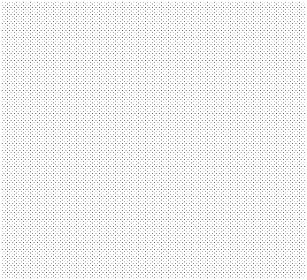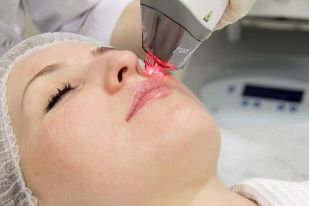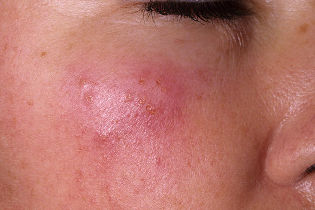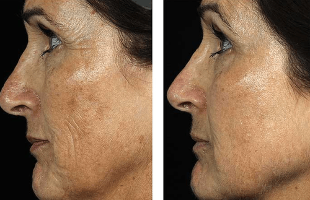Fraxel laser rejuvenation can solve many skin problems. The technology is already widespread and has almost eliminated other laser equipment for anti-aging procedures. The secret of its popularity is that fractional lasers are safer than traditional lasers.
What is Fraxel laser rejuvenation

Fraxel technology was developed in the United States in 2004. At that time, the possibility of rejuvenation using laser light was already known. However, the developers of the new method went even further: they changed the structure of the laser beam. Instead of light in a narrow direction, several hundred micro-beams of different lengths were applied to the skin at once.An ordinary laser heats the entire illuminated area, moving in the direction of the fractional point, burning the root canals inside the skin to a width of 0. 1 mm and a depth of 0, 4 - 1, 9 mm.1 cm2There can be several thousand such fractions for the skin - the damaged areas are replaced by untouched parts. According to cosmetologists, the areas exposed to radiation are called microthermal treatment zones.
Unlike other laser-based lasers, Fraxel glows all micro-areas of the skin equally at a distance of one hundredth of a millimeter.
There are several methods of fractional rejuvenation, because manufacturers have taken into account that people age differently - each type of aging has its own age-related changes. As a source, technology developers have adopted two types of lasers - erbium and tulium.
Erbium lasers affect the upper layers of the epidermis, or rather the lipid layer where water molecules are collected and stored - they absorb light energy themselves. Under the influence of high temperatures, water evaporates and the dead cells that make up the top layer of the skin are burned with a laser. Such an aggressive effect immediately causes a protective reaction of the body - increased metabolism, so the damaged areas of the skin are restored as soon as possible. On average, microtraumas take 1-2 weeks to heal and 3-4 months to fully recover. The procedure is called ablation or ablative coating. Once the skin is cleaner and lighter, pigmentation spots and keratomas disappear, fine wrinkles are removed. The first generation of devices with a wavelength of 1550 nm (20-50 microns or penetrating the surface up to 0, 02-0, 05 mm) worked on an erbium laser. Then it became clear that a more subtle technology was needed to treat the thin and sensitive skin in the eye / lip area. The wavelength was reduced to 1420 nm.
Thulium laser with a wavelength of 1927 nm is designed to heat the upper layers of the dermis, where the collagen-elastin mesh is located. The protein fibers in it change their structure under the influence of heat - they fold and condense. If you visualize them: they look like springs - but they lose their elasticity and straighten under the influence of wet facial expressions and gravity. As the collagen framework weakens, the dermis first loses its tone, then sags and wrinkles, and the top layer of skin and wrinkles form. Thus, from high temperatures, they seem to bend into springs and lift the sagging tissues behind them over time. Some wrinkles are corrected, including deep ones. Thulium laser fraction is not used separately for rejuvenation. However, its energy is effectively combined with an erbium laser.
By combining the two types of exposure, laser equipment manufacturers have achieved the gold standard of anti-aging cosmetology.
Fraxel laser radiation affects all layers of the skin, so it helps to solve various age problems.
With the advent of high-power CO2 lasers, rejuvenating treatments have become more effective. The impulses of light inside them are amplified as they pass through carbon dioxide molecules. This technology is used by a laser with ablative coating, as in erbium. However, the energy of the CO2laser penetrates deeper - up to 300 microns or 0. 3 mm. The technology allows you to achieve a visible improvement in the quality and texture of the skin: improve the skin, reduce pores, remove scars and stretch marks, correct wrinkles. The dermal optical thermolysis procedure uses a carbon dioxide laser when the radiation affects the deeper layers of the skin.
For Fractional Laser Rejuvenation
Fractional laser rejuvenation is more common in women, although it is sometimes used by men. The average age of patients is 30-50 years, plus or minus five years to the lower and upper limits. In fact, there is no strict age limit for whether it is worth rejuvenating using a sharp laser, a dermatologist-cosmetologist prescribes at the initial examination. It's just that at a younger age, your metabolism is already quite active, there is still no age-related change, and you can work with problem skin in other, more subtle ways. After 50 years, the rejuvenation of the fraction, on the contrary, can no longer give a noticeable result, because the tissues are very strongly deformed, the surface correction will give a short-term result, or perhaps no effect at all.
When laser coating is applied:

- with enlarged pores and post-acne scars;
- unhealthy pallor, with weak skin; for superficial fine wrinkles
- ;
- for hyperpigmentation and freckles;
- for traces and stretch marks.
Fractional thermolysis has been shown in facial, neck, décolleté wrinkles, wrinkles and creases, tone loss and sagging skin.
Women say that after Fraxel, the skin looks 3-5 years younger, although this is not the case for everyone.
Procedure contraindications
Any procedure using a fractional laser is contraindicated:
- Patients under 18 years of age;
- pregnant and lactating women;
- cancer patients;
- people with cardiovascular disease;
- diabetics;
- allergy patients (the doctor should be informed about the allergy to the laser itself or to anesthetics).
Laser exposure is not recommended if the skin at the site of the procedure is injured, inflamed or covered with a rash, herpes, dermatitis, psoriasis.The procedure can only aggravate existing problems, so the skin should be healthy.Relative contraindications for laser coating / thermolysis - chemical peeling or face lifting performed in the previous month. In such cases, the possibility of fraction rejuvenation should be checked by a physician.
Differences of fractional laser procedure from other types
In other lasers, similar procedures revealed the possibility of rejuvenation in fractional lasers - thermolysis was performed on diodes and neodymium, deep layers of skin were heated, on long-wavelength erbium and carbon dioxide, a common laser surface was realized. The result came from both procedures, but I had to wait a long time. After grinding and surface treatment, the skin was restored for a month and a half - not all patients were satisfied with this period. In addition, the risk of side effects remained high. When the possibility of a dosed light power supply arose, the salons began to move en masse to new technologies - fractional lasers began to be used everywhere.
Significant changes occur in such tissues after a procedure, but you need to go to a cosmetologist 3-4 times to strengthen the result.
There are also new procedures:
- carbon peeling. The top layer of skin is treated with a carbon (carbon) gel and then laser radiation is applied over it - to warm the deeper layers of the dermis. The mechanism of action is generally standard - regeneration occurs more intensively at high temperatures. However, thanks to the laser, the gel also penetrates deep enough: after a session, the pores are cleaned, the work of sebaceous glands is normalized, the face becomes cleaner and smoother. The procedure is recommended for patients with oily skin;
- Laser biorevitalization is a procedure that replaces the injection technique. A gel containing hyaluronic acid is applied to the problem area, then the skin is treated with a laser - usually a diode. With the discovery of the laser, it became clear that foreign substances could penetrate even deeper, which means that after application, any area can be treated more effectively if treated with laser light. This also happens with hyaluronic acid molecules - if they are only superficially absorbed in an ordinary cream or gel and washed off after the first facial cleansing, they fall into the deeper layers of the epidermis, where all the moisture needed for the skin is collected after the laser.
What are the advantages and disadvantages of the laser procedure - table
| Plus | Cons |
|
|
How to prepare a procedure
Preparation for fractional rejuvenation begins without consulting a dermatologist. After the examination, you must decide in advance for the procedure and personal recommendations. Restrictions generally apply to:
- lifestyle. You should refuse to visit the solarium 3-4 weeks before the procedure and use a cream with an SPF filter before going out;
- taking certain medications - antibiotics taken by every second woman over the age of 30, blood thinners. But taking medication for herpes, on the contrary, is worth it;
- cosmetic procedures. 2 weeks before the procedure, it is recommended not to perform other procedures to cleanse and rejuvenate the face, it is better to refuse even peeling at home and switch to gentle care to avoid further damage to the skin.

You must come to the salon without makeup.
It is recommended not to drink too much before the session and during the day - no tissue edema.
If you are prone to herpes, it is advisable to take antiviral drugs in preparation for the procedure.
How the procedure is performed in the salon
Procedure:
- The first thing a doctor does is disinfect the skin and apply an anesthetic. Applied anesthesia is generally sufficient.
- Then a contact gel is applied to make it easier for the laser handle to slide over the skin.
- Nozzles come in different diameters: 7x7 mm or 15x15 mm. During one activation, the session takes very little time, as the skin is illuminated by 1-2 cm2. The face and neck treatment takes about half an hour and the hands about 10 minutes.
- Unpleasant sensations usually do not occur during the procedure, but after it, when the anesthesia begins to withdraw. The skin feels hot, burning and tingling when exposed to laser, but is tolerant; because it is easier to perceive the burning of micro-regions than it is for a directed beam to burn the top layer of skin by inches.
What effect will there be after the procedure and when will it appear
On the second or third day after the procedure, when the edema decreases, the skin will look slightly dull, the tone will be smoother and the skin will be fresher. It takes time for the skin to recover, about a month. After this period, the lifting effect will be an improvement in the quality of the skin - an increase in density, elasticity, a decrease in pores, lightening of age spots.You need to do 3-4 procedures in a month to consolidate the result.After 3-4 months, when the collagen-elastin frame is restored, the face will become more dense, wrinkles will disappear, the face will look 5 years younger, even more. This condition can persist for several years if all the doctor's recommendations are followed. Salons are reluctant to make accurate predictions, as no anti-aging procedure repeals the laws of aging.

According to reviews, the result can last up to 3-5 years. It is unlikely to last longer: irreversible age-related changes can only be delayed, but then reappear and the course of treatment needs to be repeated.
Patient before and after fractional rejuvenation - photo
What complications can occur and how to avoid them
Complications are possible even if the doctor observes the procedure completely. The presence or absence of these depends on the patient's health condition and individual reaction to the procedure. If there are contraindications, the responsibility for the implementation of fractional rejuvenation lies with the patient - if he knew, but did not inform the doctor or did not hide important information about the disease, procedures performed and allergies to drugs.
Approximately 15 years of experience shows that the following side effects can occur after fraction rejuvenation:
- acne;
- herpes;
- age spots;
- persistent redness of the skin (erythema);
- persistent tissue edema.
No keloid scars or tumors were reported.
Rehabilitation period
Immediately after the procedure, patients experience pain and severe tissue edema. It will be easier if you apply a compress of ice (ice cubes wrapped in a napkin or towel or a bottle of frozen water) to the treated skin area regularly, every 3-4 hours. You can go out / work in the morning, but it is better to wait 2-3 days at home, make compresses and lubricate the skin with a tissue regeneration stimulator. No physical activity, no sunbathing or even a hot shower. Rest, hot showers, creams and compresses - at least 2 days.
Then the skin will heal - first dry crusts will form, then they will begin to peel and shed.Apart from tearing them apart, there is no need to touch them.Alcoholic cosmetics (lotions, tonics) should be discarded for the recovery period. Decorative cosmetics are allowed 2-3 days after the procedure.
Fractional laser facial skin rejuvenation views
"Anesthetic ointment is applied before the procedure itself. The ointments are also different. I did the analgesic effect in 15 minutes. The procedure itself continues. The doctor first showed the effect of the laser on a sheet of paper. The holes are burned at a distance of 1 mm. Then they burned me. . . The procedure lasted 15 minutes: face and neck. Unpleasant, but very tolerable. Problems begin when the effect of the anesthetic ointment is over. It is an elementary burn and the results are the same as the burn. The whole face is red, swollen, burned. The doctor gave these instructions: apply plenty of ointment for burns and often. It is better to use an ointment with a cooling component first. Also moisten the face more often with cool water. Severe redness disappeared somewhere on Saturday evening (aper day) There was a lot of brown crust on the burns, but the procedure is good, because on the second day you can use decorative cosmeticsand cover them all. On the third day you need to bathe or go to the bathroom in the evening. Massage the steamed face with your fingertips to loosen the crusts. Do not use a scrub! The effect is gradually increasing. After the first procedure, the plain of the face was tightened, the veins around the nose disappeared. For full effect, the doctor prescribed me 4 procedures a month with a break. Remember that Fraxel is easier on browns because it looks like sunburn. "
"I did DOT laser rejuvenation. Day 1. The procedure is painful. I was numb for an hour. But it still hurts. There is a smell of burnt meat. Immediately after the procedure, the appearance is normal, only swollen eyes. The face hurts for 2-3 hours. To put it mildly, it swells. . . The gaze of a homeless woman from three stations. Day 2. There is horror in the morning! There is no pain. But the appearance of a Tajik and a man. The skin darkens. The eyes narrow. The face is very swollen. In the evening the eyes gradually open Herpes 2 lower lipThe doctor warned me that if herpes lives in the body, it will definitely come out. That is, it came out. Beauty is impossible. . Day 3. No pain. The swelling is slowly decreasing, the crust on the face. Look terrible. Day 4. The bark gradually disappears. There is no pain. The face is strange, but not terrible. Day 5. The crust is shed. After a strong sunburn, the face turns pink. The skin looks like a baby. It eats everything that cannot be offered. All creams, all masks under the broom. Heal the lips. ı. Day 9 - a feast for the eyes! Test myself in the mirror, I can't see enough. Turgor is completely different. Under the eyes (my most painful place) everything is right. There are no wrinkles. I do not know what will happen after that. But today, for the 10th day, I am very happy. "
"I was happy to treat the most difficult scars on my face. That is, torn and boxed scars. If anyone does not know, these scars are characterized by sharp torn edges. I started this saga treatment 4 years ago. I knew the variety of different methods and part of the doctor's Dot device. By the way, the doctor promised me to make a perfectly smooth face in 3 procedures. I realized that it was mentally impossible. Finally, I have mixed scars. But my hope burned. The day of the first procedure came. God! Hell was painful! The smell of burnt skin was still gone. I had to sit at home for a week, stain my face with a tissue repair stimulant, and be afraid of the reflection in the mirror, because there was a Kruegger in the form of a woman. , but the wounds were in place. To my surprise, my whole face turned into a small dot. Laser. That's what I didn't expect! Perfectpromised smoothness. And in the end they added violations. I thought, "Okay, okay, " and went through the second procedure. And then the third. Personally, my eyes are dazzling with such smoothness. I think nothing has changed! Traces of the laser in the form of a grid, by the way, are still with me. They are not surprising, but if you look closely, you can see them. I trick them with ultrasonic massage, mesoscooter and peeling. I'm no longer a foot in the dot! Absolutely bad for my scars! "
Fractional rejuvenation, of course, has many advantages. However, patients have negative opinions, and there are cases when such a procedure causes health problems in such people. This often happened for a variety of reasons, mainly due to the contraindications to laser rejuvenation. After the procedure, play safe in advance to protect yourself from possible negativity - go to the doctors, get tested, listen to not one, but several cosmetologists. Again, safety and health are two inseparable things.







































